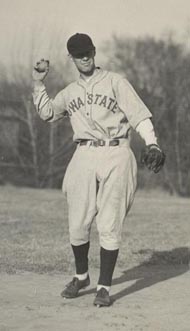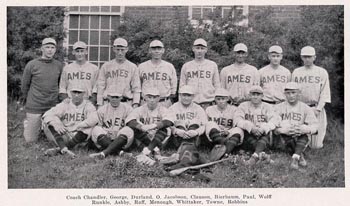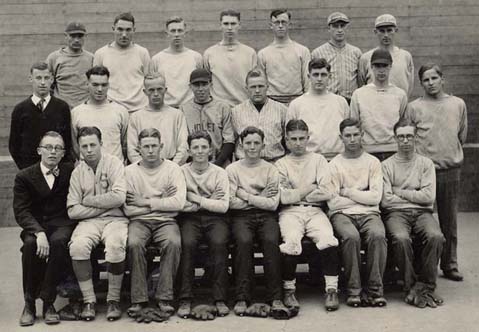|
The Lineup:
Cyclone Baseball, 1892-2001
The Ames Nine
Coaches
Timm
List
Fields
The Diamond Darlings
Team Photos
1888-1929
1940-1971
1974-1988
Cyclones in the Majors
 |

1911 Varsity Baseball team
Baseball
(or “base ball”, as it was known at the time) emerged during the
latter half of the nineteenth century as a popular recreational game.
It was played very informally, with little of the equipment and few of
the rules that now characterize the game.
Click
on the picture to the right and note the small size of the glove and the lack
of webbing between the thumb and forefinger. Players fielded the ball
barehanded until the 1890s. Not until 1920 would players enjoy gloves
with preformed pockets. Helmets are not incorporated until 1941 and
not required in professional baseball until 1958.
Many of
the rules we take for granted were also unheard of during the early years
of baseball at Iowa State. For example, not until 1889 do four balls
become a walk - the 1888 team below would have not used that so familiar
rule. And not until 1901 do foul balls count as strikes.
Baseball in Iowa grew as it did in the rest of the nation and
students in Ames circled the diamond regularly during their scarce
free time. The first formal game was played in 1892, but a writer
for the 1895 Bomb supposed, “that the oldest alumnus cannot remember the first
game of base ball played at I.A.C.” One of the firsts sports played
on the campus, games were generally casual contests between groups of
friends but as interest piqued classes would often challenge each
other and occasionally the game pitted students against faculty.
Designed
to facilitate game play between universities, the Iowa Intercollegiate
Base Ball Association formed in the spring of 1892. Initially it
consisted of the Iowa Agricultural College (ISU), Grinnell College,
State University (UI), Drake University, Iowa College (UNI). Cornell
College of Mt. Vernon joined the Association in 1893. To stimulate
competition, the league set up a trophy to be awarded to the season
champions until one team won three consecutive years and won the
forty-dollar silver bat outright. A strong team from the beginning,
I.A.C. eventually won possession of the bat.
The
team was consistently plagued by a lack of players returning to
college for the next season.
The days of recruiting players and athletic scholarships were
not yet visible, leaving teams to depend on who turned up to play each
spring. Then, as today, players often left college to play
professionally. Major league franchises draw from much younger teams
than their counterparts in football and basketball, who often wait to
draft until a player is well into college.
One
of the highlights of baseball in Ames was tying Oklahoma for second
place in the 1923 championship.
Another
dimension of baseball during the early years of the game at Iowa State
was class
baseball, a very popular legacy from the time before baseball was a
competitive, intercollegiate sport. Without other teams from other
colleges to hone their skills against, students created teams from the
student body and furthered the natural rivalry between classes. Games
challenged one class to conquer another or members of the faculty on the
diamond. As intercollegiate play became more common, this tradition
evolved into more of a junior varsity-type play to introduce freshman
students to baseball at the college level. Players often went on to play
for the Iowa State team after a year with the freshman team.
|
|
_small.jpg)
Iowa State Base Ball team, 1888 [click for enlarged
version]

[click for enlarged
version]

1923 championship team [click for
enlarged version

1928 freshman baseball team [click for enlarged
version] |